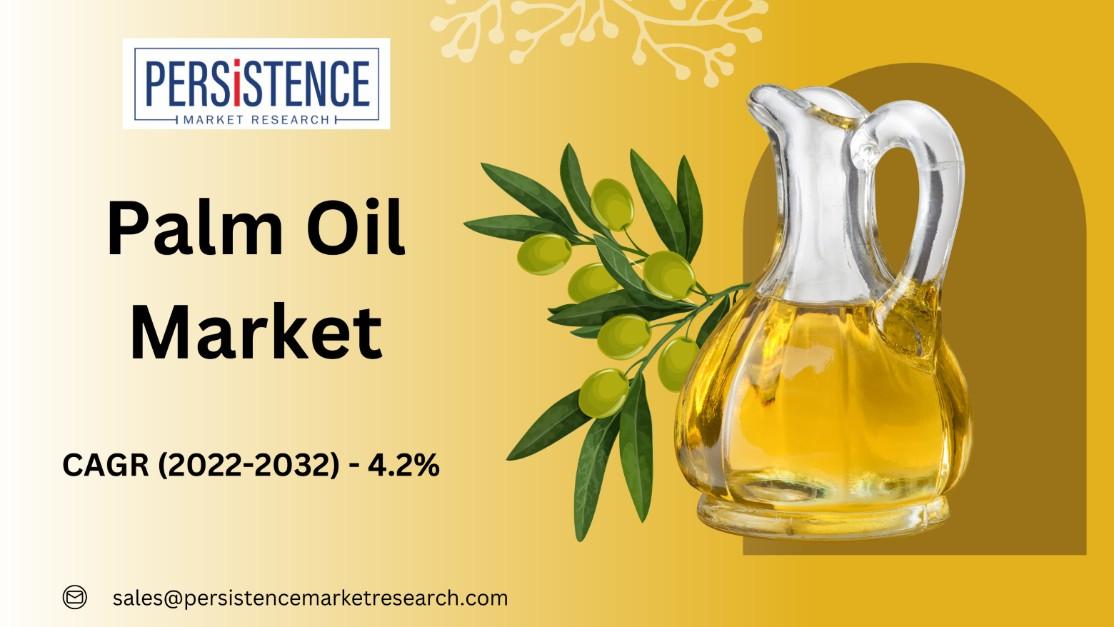Palm Oil Market: Key Drivers and Restraints
Influencing the Sector
The global palm oil market continues to be a pivotal player in the global economy, driven by its extensive applications in food products, cosmetics, and biofuels. As one of the most widely consumed vegetable oils worldwide, palm oil's market dynamics are influenced by a complex interplay of drivers and restraints. This press release explores the key factors shaping the palm oil market, from growth drivers to challenges and regulatory constraints.
Market Overview
The global palm oil market is projected to grow significantly from US$ 59.75 billion in 2022 to approximately US$ 90.18 billion by 2032, marking a compound annual growth rate (CAGR) of 4.2%. Palm oil consumption, which currently holds a substantial share of the global edible oil market (2530%), is particularly dominant in South Asia, commanding a leading value share of 39.7%. Consumer preferences for natural and additive-free edible oils are driving this growth, with transparency and traceability becoming increasingly important factors in purchasing decisions.

Key Drivers
1. Versatility and Cost-Effectiveness
Palm oil's versatility and cost-effectiveness are significant drivers of its market growth. It is widely used in food processing due to its stability at high temperatures and long shelf life. Additionally, its applications in cosmetics, pharmaceuticals, and biofuels contribute to sustained demand.
2. Rising Global Population and Urbanization
The growing global population and urbanization trends drive demand for processed foods, personal care products, and biofuels, all of which rely heavily on palm oil. Emerging economies, particularly in Asia and Africa, are witnessing increased consumption as disposable incomes rise.
3. Biofuel Demand
The shift towards renewable energy sources has boosted the demand for palm oil-based biodiesel. Governments worldwide are implementing policies and mandates to reduce carbon emissions, further driving the biofuel sector's growth and palm oil consumption.
4. Technological Advancements
Technological innovations in agriculture, such as precision farming, drones, and satellite imaging, enhance palm oil production efficiency. These advancements improve yield, reduce environmental impact, and support sustainable practices, contributing to market expansion.
5. Health and Nutrition Trends
Despite concerns over its high saturated fat content, palm oil's nutritional profile and functionality in food products continue to drive demand. Ongoing research focuses on developing healthier palm oil variants with reduced saturated fats, meeting consumer preferences for healthier options.
Key Restraints
1. Environmental Concerns
Deforestation, habitat destruction, and biodiversity loss associated with palm oil plantations remain significant concerns. Environmental groups and consumers advocate for sustainable practices, prompting regulatory scrutiny and consumer backlash against non-certified palm oil.
2. Health Concerns
The high saturated fat content in palm oil raises health concerns related to cardiovascular diseases and obesity. Consumer awareness campaigns and regulatory pressures in certain markets have prompted shifts towards healthier alternatives and stricter labeling requirements.
3. Regulatory Challenges
Regulatory complexities and varying standards for sustainable palm oil production pose challenges to market players. Compliance with certification schemes like the Roundtable on Sustainable Palm Oil (RSPO) requires investments in sustainable practices, affecting operational costs.
4. Price Volatility
Palm oil prices are subject to global supply-demand dynamics, weather conditions, and geopolitical factors. Price volatility affects profitability for producers and creates uncertainty in planning and investment decisions across the supply chain.
5. Market Competition
Intense competition among palm oil-producing countries and alternative vegetable oils impacts market dynamics. Price competitiveness, quality standards, and geopolitical factors influence market share and trade dynamics, posing challenges to sustained growth.
Future Outlook
The future outlook for the palm oil market is influenced by several key factors:
1. Demand Growth: Demand for palm oil continues to rise due to its versatility in food products, cosmetics, and biofuels. Emerging markets in Asia, particularly India and China, drive significant demand growth.
2. Sustainability Concerns: Increasing global awareness of environmental and social impacts associated with palm oil production has led to calls for sustainable practices. Certification schemes like RSPO (Roundtable on Sustainable Palm Oil) are gaining importance.
3. Regulatory Changes: Governments and international bodies are implementing regulations to promote sustainable palm oil production and curb deforestation, influencing market dynamics.
4. Technological Advancements: Innovations in agricultural practices and processing technologies aim to enhance yield efficiency and sustainability in palm oil production.
5. Market Dynamics: Price volatility, influenced by factors such as weather conditions, geopolitical events, and currency fluctuations, continues to impact market stability.
6. Alternative Oils: Increasing research and development into alternative vegetable oils, such as soybean and canola oil, pose competitive challenges to the palm oil market.
7. Investment and Expansion: Continued investment in palm oil plantations, especially in regions like Southeast Asia and Africa, aims to meet growing global demand.
In summary, while the palm oil market faces challenges related to sustainability and market volatility, its strong demand fundamentals driven by diverse applications and growing economies provide opportunities for growth and innovation in the industry.
Conclusion
The palm oil market remains a vital component of the global economy, driven by its versatility, widespread applications, and growing demand. Understanding the interplay of drivers and restraints is essential for stakeholders to capitalize on opportunities and address challenges effectively. As the industry evolves, proactive measures towards sustainability, innovation, and regulatory compliance will be imperative for long-term success.
